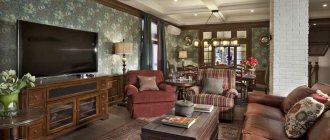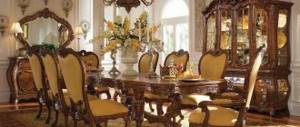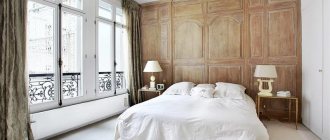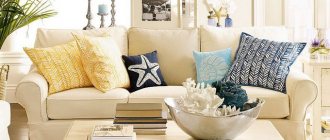Interior in Biedermeier style: Features
The Biedermeier style in the interior implies the desire to ensure maximum comfort.
At the same time, it belongs to the category of vintage, and motifs of Empire and Classicism can be traced in it. At the same time, it does not belong to the palace design trends, therefore it is devoid of ostentatious luxury.
Any item is selected based on compliance with 3 main criteria:
- high quality;
- practicality;
- feasibility of use in a specific room.
What should the furniture be like?
The collections of modern manufacturers, as a rule, fit well into the idea of Biedermeier, because their main characteristic is practicality. Mixing styles is acceptable, but simplifying the details is necessary. At the same time, furniture in the Biedermeier style should be neat and comfortable, absolutely functional - no useless additions.
When choosing furniture, the main attention should be paid to the good quality of the models and their appropriateness in a particular setting. The style puts family values and simple everyday comfort at the forefront, and sets are selected based on this; It is important here to avoid ostentatious wealth. Products made from light wood have an advantage: chairs, tables and sofas made using ash, pine, maple, birch, cherry, and pear would be an excellent solution. Distinctive features of “correct” furniture are curved turned legs, curved backs of chairs and sofas, and the presence of floral ornaments. When choosing suitable upholstery, you should pay attention to striped grosgrain and colored chintz; nails with porcelain heads can be used to secure facing fabrics.
Ideal beds are very simple in design, the height of the backs on both sides should be the same. Smooth wood without decorations becomes the optimal basis for the product, but colorful textiles combined with curtains and tablecloths are acceptable.
According to Biedermeier, large round tabletops can be used in the interior; furniture legs can be of various shapes. Corner cabinets, dressing tables, small harpsichords, showcases, shelves for flowers and books fit perfectly here. Indoor plants are natural additions, their number is not limited by frames, but they need beautiful stands, maybe at different levels.
"Clean room"
In the era when the design known as Biedermeier interiors was invented in Germany and Austria, “clean rooms” appeared in the homes of wealthy citizens. The burghers wanted to keep up with the aristocrats. However, the funds did not allow them to beautifully decorate the entire house. In order not to lose face in front of the guests, they allocated a special room for their reception. It was furnished with the best furniture that the owners could afford, and decorated in every possible way.
If you have a large private house with a separate room for guests, you can create a Biedermeier style interior there.
An obligatory element of its furnishings is a sideboard with the best dishes, which is displayed to the guests.
There should also be a sofa and armchairs so that visitors can be comfortably accommodated and engaged in conversation. Depending on the size of the room, a dining table and chairs may not be available. The fact is that the burghers rarely held feasts in their homes, and if they invited guests to a dinner party or lunch, they set the table in the dining room.
Color scheme and finishing.
Most often, for this interior style, designers advise using light colors and their shades. But sometimes dark colors are also used, the main condition here is that the color is not bright, muted, without disturbing the overall atmosphere of home comfort and tranquility.
Walls are most often decorated with wallpaper with a simple pattern, for example with a natural theme. The wallpaper color is light. If you chose wallpaper without a pattern, and you subsequently wanted to bring freshness to the interior by decorating the walls, you can simply paint the walls with watercolors, which is allowed and even encouraged by “Biedermeier”.
The ceiling of this style is decorated in white. It can be decorated with simple-shaped skirting boards. The floor can be done in brown tones. It must be decorated using natural wood. It can be parquet or laminate. It is not advisable to use ceramic tiles, as they create a “cold” effect, which is completely unacceptable for this style.
Interior in Biedermeier style: Furniture
When decorating an interior in the Biedermeier style, furniture is given a special role. It should be as comfortable as possible and evoke admiration for the craftsmanship. This style is characterized by the use of furniture with retractable parts. For example, a secretary with a table hidden behind a folding door.
The use of lacquered furniture is encouraged, and sofas and armchairs should be upholstered in jacquard and other shiny upholstery fabrics.
Biedermeier in the interior
Interiors in the Biedermeier style are significantly different from the interiors of the past period - now they are characterized by intimacy, respect for proportions, simple shapes and light colors. The premises were spacious and well lit, making them comfortable and pleasant to stay in. The walls were painted in light colors, mostly white, or covered with embossed wallpaper, often striped. They tried to combine the pattern of the furniture upholstery with the color of the window curtains. As for the ornament, palmettes from the Empire era continued to be used, only the background was often chosen differently, for example, purple.
The severity of classicism was replaced by natural forms and smoother lines. Some designs were original and practical. The beginning of multifunctional, combined furniture - transformable and sliding - was laid.
The criteria for household items began to be considered, first of all, high quality and reliability. Preference was given to simple forms; there was no excess of decorative elements. Furniture pieces were enlivened by brightly colored upholstery, and curtains in rich colors were hung in rooms.
During the heyday of the Biedermeier style, the phenomenon of the “clean room” appeared. Most often, this concept referred to living rooms, which contained quite a lot of furniture. As a rule, it was grouped in the center of the room so that there was a minimum of empty space.
An integral part of the Biedermeier style interior were all kinds of wardrobes and chests of drawers. The simple shapes made the colors and textures of the wood stand out more. Most of the types of furniture that appeared in that era are still relevant and are used to decorate a classic interior.
Biedermeier inherited simplicity and laconism from the Empire style. The style also borrowed some elements of Empire architecture: columns, pilasters, cornices, elements of “antique” decor.
From the English tradition, Biedermeier adopted the desire for practicality. The walls of the rooms were decorated with wallpaper, the pattern of which repeated the pattern of the furniture upholstery. The simplicity of the form was compensated by the brightness of the colors.
Chairs, armchairs, and sofas increasingly have curved backs and armrests. The fashion for bent furniture legs also returned, so Biedermeier was often compared to Rococo.
A typical piece of furniture is a small cabinet with a plywood door. The doors and walls of cabinet furniture were covered with thin sheets that did not deform over time, which became another indicator of practicality.
The living room becomes the center of attention - it copied an aristocratic salon, but it was not only an indicator of prosperity, but also a normal living room.
Another characteristic attribute of the Biedermeier style interior was the armchair - massive, but solid and comfortable, most often covered with tapestry.
The shapes of a sofa typical of the Biedermeier era are reminiscent of Empire style, only they are extremely simplified and devoid of excessive luxury. The armrests and legs of the chairs are curved, like most pieces of furniture.
As for fabrics, they could be different - satin, silk, wool, tapestry. The main thing is calm colors and characteristic motifs: a combination of stripes and palmettes with rosettes or individual flowers scattered across the surface.
A wall clock with a pendulum in a simple “case” is a typical element of the Biedermeier era.
In general, we can say that the Biedermeier style is characterized by eclecticism - it originated as an alternative to previous eras and an attempt to find a balance between appearance and comfort.
Interior in the Biedermeier style photo gallery
LiveInternetLiveInternet
Quote from Marie_Mary
Read in full In your quotation book or community!
Biedermeier style in the interior.
Part 1 Biedermeier is a tricky word. However, this word denotes a concept that is simply simple and ordinary.
The Biedermeier artistic style is a simplified style, devoid of pretentiousness and aristocracy. Very often we arrange and decorate our home according to the rules of this particular style. Because Biedermeier is a style of home comfort, everyday unpretentiousness and simple earthly joys.
It is also called bourgeois or philistine. Just don’t immediately give a negative assessment to this style. Let's first figure out what it is, what advantages and disadvantages it has and what home it is suitable for.
History of style
The Biedermeier style emerged in the early 19th century in Germany. And it owes its name to the name of Gottlieb Biedermeier (pseudonym of the German poet Ludwig Eichrodt). One of the characters in his ironic works was a provincial schoolteacher, who was distinguished by petty-bourgeois tastes, philistine interests and complete contentment with his life.
This style very quickly established itself in Germany and Austria. And not only in everyday life, but also in art. And here is the paradox: it was in Europe that this style was and continues to be treated ironically, considering Biedermeier to be the style of the bourgeoisie and people with low aesthetic demands.
Biedermeier came to Russia during the time of Pushkin. And although the bourgeois philosophy of this style did not correspond much to the general mood of the era, in Russia the Biedermeier style fit perfectly into the interiors of noble houses, landowners' estates and even royal dachas.
Biedermeier replaced the pretentious Empire style and established himself through everyday comfort, home comfort and convenience. As a matter of fact, this style appeared precisely as a result of the search for simple truths and life values, peace and quiet. And later it became an indicative example of how, with the help of modest means, you can solve the problem of a laconic and stylish interior.
Philosophy of style
A characteristic and even distinctive feature of the Biedermeier style can be called a peculiar poeticization of the world of things, reflecting the bourgeois worldview. And at the same time – simplicity and unpretentiousness. By the way, the literal translation of the word “bieder” is simple-minded, philistine. Historically, the interior in this style is asymmetrical and disproportionate. The main motto is coziness and comfort, the main motive is flowers and stripes.
The main emphasis of the style is aimed at creating a cozy and calm atmosphere at home, where life flows slowly and pleasantly. However, the desire for a calm and measured life, which forms the basis of this style, is quite understandable. A series of wars and revolutions simply forced people to seek peace in everyday life and in the structure of their everyday life.
Biedermeier, first of all, is the style of residential (domestic) interior. That is why it best meets pressing human needs: convenience, practicality, functionality. This style is a clear example of how the unity of the spiritual and objective world of people arises.
Biedermeier is sometimes called simplified Empire style. His artistic expression is based on ancient motifs. But unlike the Empire style, it abolishes the imperial pathos of palace columns and gives preference to soft and rounded forms. We can say that Biedermeier, from all interior styles, selects exactly what is close in spirit to the middle class and the ordinary person.
Textiles and accessories
Since the Biedermeier style is very simple, it is not oversaturated with a large number of accessories. It is best to decorate the walls of rooms with small paintings and photographs in simple wooden frames. It is very important that the color of the frames matches the color of the wooden furniture. Living plants and flowers will also decorate the interior very well. You can place tubs and pots with plants around the perimeter of the room, and also decorate tables with vases with freshly cut bouquets of flowers.
There are quite a lot of textiles in the design of this interior. With its help, the rooms receive that homely coziness for which the style is famous. The main attribute of any room is the carpet. The carpet should be very soft, with long pile, but very small. Such a rug does not have to cover the entire floor; it spreads across the center of the room and leaves a sufficiently large area of the floor open.
Curtains are another important attribute. They are made from quite expensive materials - velvet and muslin. The main decor of curtains is tassels. It is the tassels that give the window decor the necessary sentimental romanticism.
Here are a few more options for using textiles in a given interior:
- Bedspreads.
- Tablecloths and napkins.
- Canopies over the beds.











